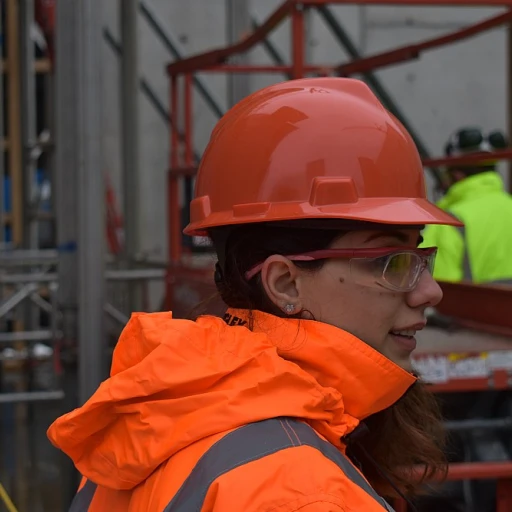Understanding the Corporate Culture
Decoding the Unique Business Environment
Understanding the corporate culture in the Arabian Emirate business landscape is essential for effective engagement with senior leaders. Culture is more than just a buzzword—it's the bedrock of any organization that influences leadership styles, decision-making processes, and the overall success of the company. For those aiming to reach the executive level, grasping these nuances is pivotal.
When engaging with senior managers, it's essential to bring the right questions to the table. This not only helps in aligning with the organization's strategic vision but also reveals your critical thinking and problem-solving skills, key attributes valued at the senior level. Consider how the culture impacts employees’ work life and how senior executives prioritize professional growth and development within the team.
However, understanding the Arabian Emirate corporate culture isn’t just about observation; it requires active engagement. Reach out to senior leaders and pose thought-provoking questions that extract insights into the organization's ambitions and challenges. This dialogue can reveal how leadership communication fosters a collaborative environment, which is indispensable for long-term success.
As you decode the organizational ethos, remember that culture isn’t static. Be open to its evolving nature influenced by strategic planning, risk management, and adaptability initiatives. This dynamic approach will equip you with the strategic questions needed to navigate the business landscape effectively.
Navigating Strategic Vision and Goals
Aligning with Strategic Objectives
Understanding the strategic vision and goals of a company is pivotal for leaders aiming to navigate the intricacies of the Arabian Emirate business landscape. By seeking insights into a company’s objectives and the challenges faced at the senior level meetings, leaders can foster a culture of growth and success.- Engagement with Senior Executives: Engage with senior executives to discuss their strategic planning and the role they envision for team members in achieving these objectives. This will help in aligning career goals with the strategic vision.
- Strategic Questions: Pose thought-provoking questions that delve into the long-term strategic vision of the company. Good questions often revolve around how leaders prioritize decisions and integrate employee engagement into these strategies.
- Leadership Style and Decision Making: Assess the leadership style adopted by senior leaders, and how these styles influence decision making and problem solving. Understanding these nuances can help in guiding organizational growth and adaptability.
- Team-Level Communication: Investigate how information is communicated from senior leaders to team members and the efficacy of follow questions to ensure clarity and alignment with the strategic goals.
Assessing Leadership Communication
Examining Leadership Communication Techniques
Understanding how leadership communicates within a company is vital for organization-wide success and effective decision making. Effective communication influences not only the company culture but also employee engagement and professional development. Strategic leaders in the Arabian Emirate business sphere need to articulate their vision clearly to foster a strong, cohesive team. Effective leaders must ask themselves important questions such as:- How do you ensure your message is clear and resonates with all team members?
- What strategies do you employ to encourage open dialogue within the organization?
Evaluating Risk Management Approaches
Understanding Risk Through Strategic Inquiries
Engaging with senior leaders in the Arabian Emirate business landscape requires a thoughtful approach to risk management. Recognizing how these leaders assess and mitigate risks can reveal much about their decision-making process and leadership style. To gain insights, consider asking strategic questions that delve into their thought processes and risk-taking abilities.- What are your top priorities when evaluating risks? This question can help you gauge how senior executives prioritize different aspects of risk, ranging from financial to operational factors. Understanding these priorities can shed light on the organization's decision-making framework.
- How do you incorporate diverse perspectives into risk management? Inclusion of various perspectives in decision making can lead to comprehensive solutions. This question assesses the leader's commitment to fostering a culture that values input from team members at all levels of the organization.
- Can you share a scenario where risk-taking led to success for the company? Real life examples provide valuable insights into a leader's experience and ability to drive growth through calculated risks. It also highlights the organization's adaptive capabilities during challenges.
- What role does innovation play in your risk management strategy? Exploring how leaders integrate innovative thinking with risk management helps in understanding their approach to fostering employee engagement and cultivating an environment that embraces change.
Fostering Innovation and Adaptability
Encouraging a Culture of Innovation
In the dynamic business landscape of the Arabian Emirate, fostering innovation is crucial for maintaining a competitive edge. Senior leaders must ask themselves how they can cultivate an environment where creativity and adaptability thrive. This involves questioning existing processes and encouraging team members to think outside the box. Leaders should consider: What barriers exist that might stifle innovation? How can these be removed to promote a more open and flexible culture?
Adapting to Market Changes
As markets evolve, so too must the strategies and operations of a company. Senior executives need to be adept at recognizing shifts in the market and adjusting their strategies accordingly. This requires a keen understanding of both internal and external factors that influence business success. Leaders should engage in strategic planning that anticipates future challenges and positions the organization for sustainable growth. Key questions include: What are the emerging trends that could impact our business? How can we prepare our team to adapt to these changes?
Promoting Continuous Learning and Development
To remain innovative, companies must invest in the professional development of their employees. This not only enhances individual career growth but also strengthens the organization as a whole. Leaders should prioritize creating opportunities for learning and skill enhancement. Consider asking: Are we providing our employees with the tools and resources they need to succeed? How can we integrate continuous learning into our corporate culture?
By addressing these areas, senior leaders can ensure that their organization remains agile and forward-thinking, capable of navigating the complexities of the modern business environment.
Building Collaborative Relationships
Strengthening Synergies with Leaders and Teams
In the dynamic business environment of the Arabian Emirates, forming productive alliances requires understanding the complexities of organizational culture and strategic objectives. Interacting with senior leaders and aligning with their vision is crucial for fostering an atmosphere conducive to success and growth. Key to this process is positioning yourself as a partner in decision-making. Being well-versed in the company’s strategic plans and actively engaging in discussions reflects your commitment to contributing meaningfully to organizational goals.- Engage Thoughtfully: Initiate thought-provoking questions that demonstrate a deep understanding of business priorities and challenges. This will not only showcase your insight but also highlight your readiness to collaborate.
- Benefit from Diverse Perspectives: Encourage diverse opinions within teams to enhance problem-solving and decision-making processes. Leveraging the insights of team members and understanding different leadership styles enriches the conversation.
- Promote Open Communication: Establishing channels for ongoing dialogue ensures that senior executives feel connected to the day-to-day operations and challenges faced by employees.












